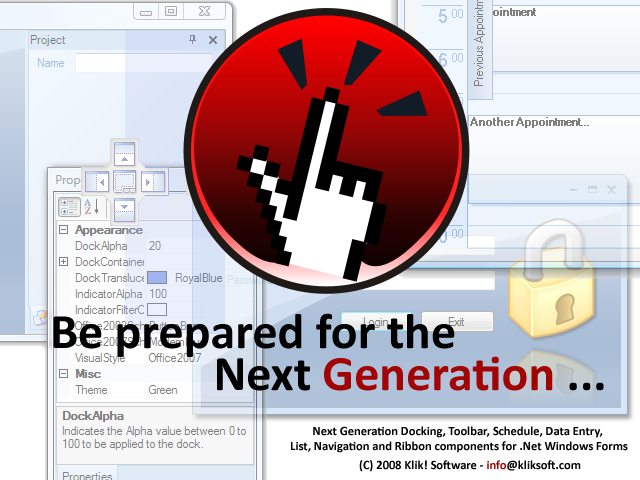Klik! DesignerLib.Net for Windows Forms,
part of Klik! Windows Forms Library, is a set of components to add screen/form design
ability to your applications. It's based on the same Windows Forms designer technology
you use daily in Visual Studio thus provides a rich and easy to use form/screen
design environment.
Rich Feature Set
As indicated above, Klik! DesignerLib.Net is empowered with the same technology
you use daily to design your Windows Forms screens. It provides you the features
you use daily such as :
- A design surface where you can put any type of Windows Forms control, both built-in
.Net Framework and 3rd party controls are supported.
- Ability to freely position and resize of controls on a designsurface using both
mouse and keyboard.
- Support for standard commands such as cut/copy/paste, control alignment, etc.
- Built-in UndoEngine to support undo/redo actions.
- Full support for Control/Component designer specific features such as verbs, smarttags,
snaplines, etc. Custom designers you created for your controls are supported as
well.
- Ability to save/load the design to/from a simple XML storage.
- A ToolBox control which acts similarly to the one you have in Visual Studio.
- An enhanced PropertyGrid control to easily filter the properties you want to show
in it.
Next Generation Look
Klik! DesignerLib.Net does also present all these features with a nice look.
The common component provided with the library, KFormManager, allows you to skin
your forms with Office 2007, Office 2003 and custom styles. ToolBox control support
Office 2007, Office 2003 and Custom look as well.
It can't be much easier to create a modern an appealing designer application with
Klik! DesignerLib.Net.
Next Generation Design-Time Experience
As a core share with other Klik! Windows Forms Library components, each component
has it's own quick access menu associated with it which allows you to do many things
with a single click such as applying styles, getting help, etc.
Targets Your Development Platform
Klik! DesignerLib.Net is offered in 2 dlls which each targets different .Net framework
versions as v2.0 and v3.X.
